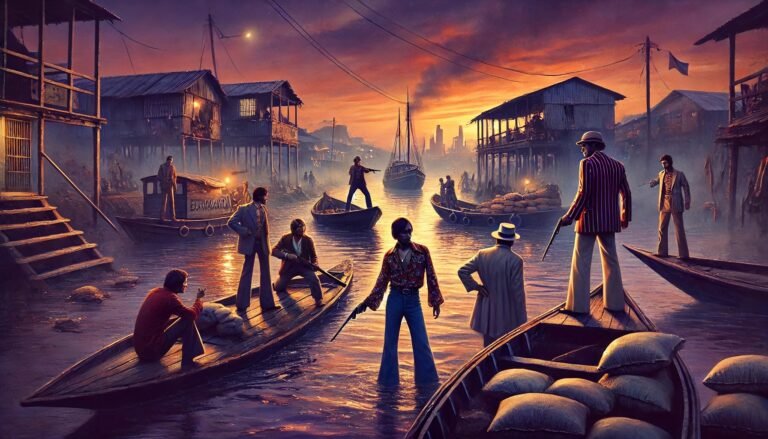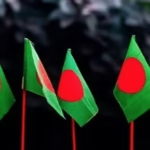Chapter One: The Crimson Pact of Sutrapur
It was 1975. Dhaka wore its post-war wounds like fresh bruises—raw, tender, and barely concealed under the fabric of nationalism. Sutrapur, once a proud neighbourhood humming with tales of resistance, now harbored a different kind of story. One told in whispers. One written in blood.
In a dimly lit room above a pan-bidi shop near Tikatuli, Kalu Majhi — once a river smuggler, now kingpin of the southern rackets — sat hunched over a dusty ledger. The room smelled of ganja, sweat, and fear. Kalu’s empire stretched from the Kamalapur rail yards to the teeming ghats of Sadarghat. Under his command ran a seamless operation of protection extortion, prostitution dens from Gandaria to Jatrabari, and narcotics ferried from Barisal on fishing trawlers.
His monopoly, however, was bleeding.
Because Jabbar “Khokon” Bhai — a former Mukti Bahini foot soldier turned street demagogue — had returned from hiding in Madaripur with his own ambitions. Charismatic and cold-eyed, Khokon built his own crew from the orphans and fugitives of the Liberation War. They called themselves “Agun Dal”—the Fire Gang.
The Agun Dal first struck in Mitford, torching a warehouse storing contraband cough syrup laced with codeine. A month later, one of Kalu’s lieutenants, Babul “Launda,” was found by the Pagla bridge, mouth stuffed with fake Indian rupees and eyes gouged out. The message was clear: Khokon wasn’t just after turf—he wanted a throne.
The air in Sutrapur turned thick with anticipation. Cops in Dhanmondi and Wari were already choosing sides, slipping brown envelopes under the table, playing kingmakers in shadows. The city’s underbelly was about to rupture.
Chapter Two: The Saltwater War
The Buriganga knew secrets. Every stolen consignment of heroin wrapped in jute sacks. Every trafficked girl from Noakhali. Every crate of fake foreign whisky made in Tejgaon’s illegal distilleries.
Kalu Majhi’s marine routes had survived war and embargo. His boats carried salt and onions during the day, hashish and pharmaceuticals by night. But Khokon, with his ex-combatant network, had blockaded the river near Keraniganj. A floating checkpoint manned by defectors from the Navy and armed with Chinese rifles smuggled from Myanmar.
What followed was “The Saltwater War.”
On a stormy night in May, a skirmish broke out near Babubazar Bridge. Kalu’s enforcer Shafi “Jat” ambushed Khokon’s trawler, sinking it with Molotovs crafted in Islambagh workshops. Five bodies surfaced the next day — their hands bound, mouths gaping in a permanent scream.
But Khokon didn’t grieve. He retaliated with a symbolic strike: bombing the Sadarghat launch terminal’s underground market. Casualties spilled over to civilians, and public outcry rattled even the military offices in Dhaka Cantonment.
The Deputy Commissioner of Dhaka, recently appointed by the new regime after Sheikh Mujib’s assassination, announced an “Operation Shuddhi.” But the raid only led to the arrest of minor players. The real puppeteers, from their hideouts in Hazaribagh and Kamrangirchar, kept dancing.
By June, the lines between criminal and political had blurred. Local leaders began to whisper that Khokon had backing from factions within the new intelligence wing. Kalu, in desperation, sought help from an old warlord of Chawk Bazar — Haji Nuruddin — retired smuggler and feared patriarch.
Nuruddin agreed, but with a condition: Khokon must die in Ahsan Manzil, the city’s old Mughal palace, where all Dhaka must hear the echo.
Chapter Three: Echoes in Ahsan Manzil
The final play was Shakespearean in its violence.
On the 16th of July, under the waning moon, Kalu’s men infiltrated a wedding ceremony near Ahsan Manzil, where Khokon was expected to attend under the guise of peace talks. Wearing lungis and carrying firearms hidden in trays of jilapi, they struck just as the bride’s brother raised the first toast.
Khokon survived the initial hail of bullets, dragging his bleeding leg into the palace museum. The chase was cinematic. Gunshots shattered colonial chandeliers. A terrified curator hid behind the Maharaja’s grand piano. Blood dripped onto antique Persian carpets.
But Khokon had one last card. His teenage brother, Jummon — born during the war — had been shadowing the attackers with a TT pistol. In a scream of vengeance, Jummon took down two of Kalu’s best before he was felled by a bullet in the spine.
By sunrise, 17 were dead.
Among them: Shafi “Jat,” Jummon, and three innocent attendees of the wedding.
Khokon was captured, barely alive, and taken by intelligence officers to a “safe house” in Uttara. Kalu Majhi disappeared the next day. Some say he fled to Chittagong; others whisper he was eliminated by his own men on the instructions of a political rival.
Dhaka was never the same.
The newspapers called it “a gangland war rooted in the post-war chaos.” But locals remember it as “Rokter Bhoy” — The Fear of Blood. It triggered a crackdown unseen since ’71. Special Task Forces swept through Gandaria, Sutrapur, and Kamrangirchar, dismantling prostitution hubs, confiscating counterfeit presses, torching riverboats suspected of trafficking.
But it was too late.
The underworld had matured. Splinters of both gangs resurfaced later — under new names, in new alliances — some turned into businessmen, others politicians.
And in the quiet galleries of Ahsan Manzil, under glass cabinets and chandeliers, the scent of burnt cordite still lingers — if you know where to sniff.



